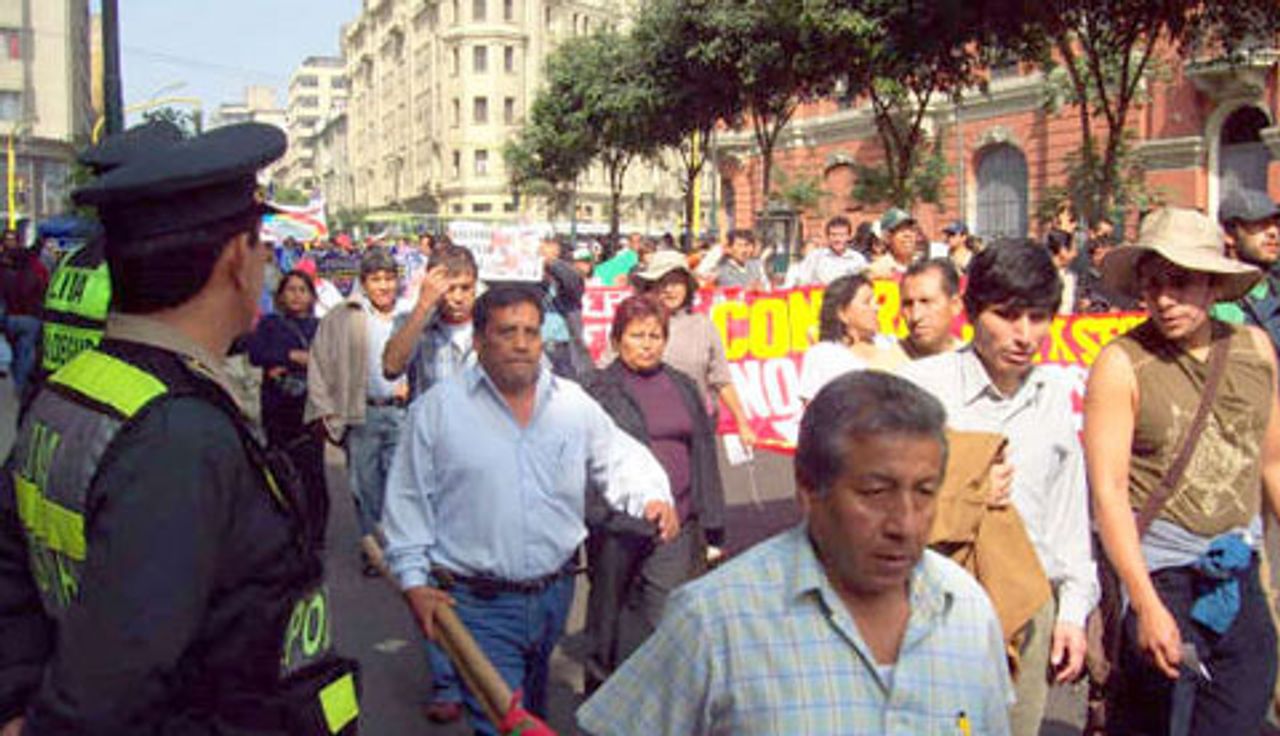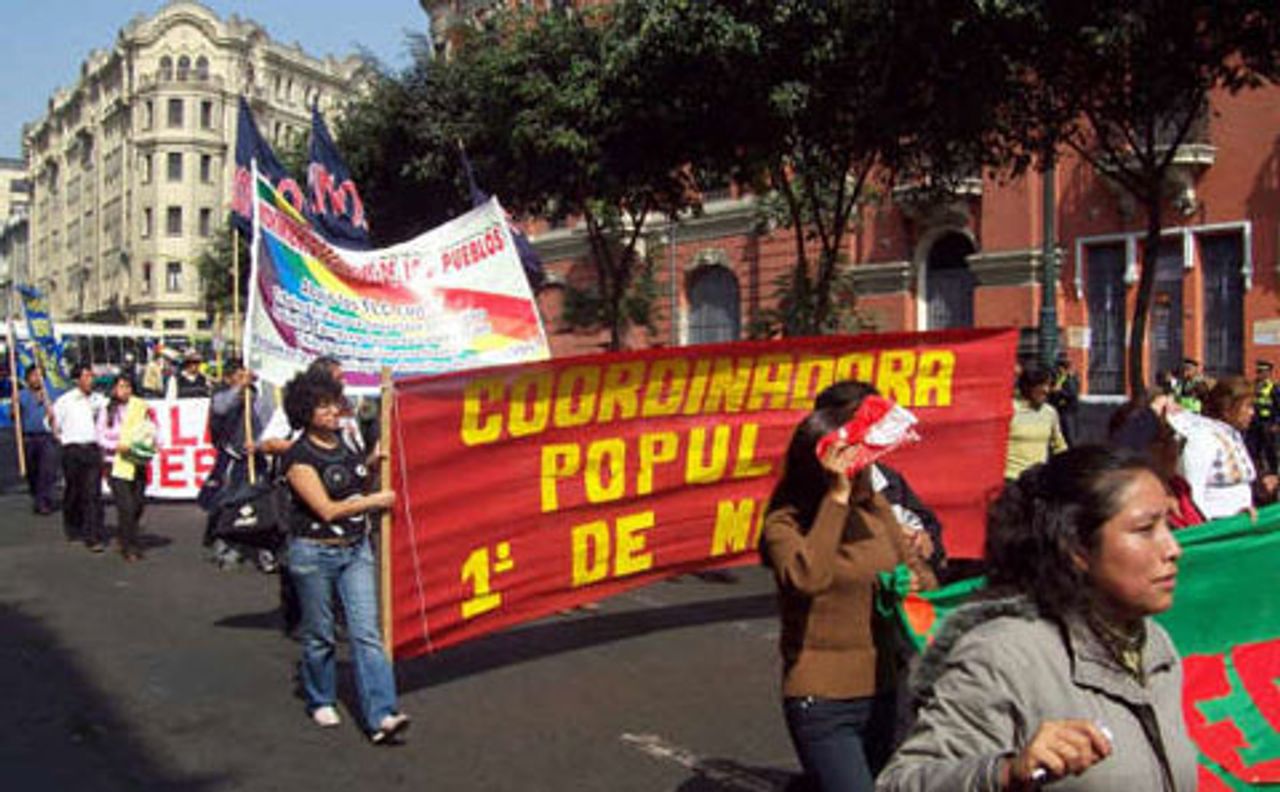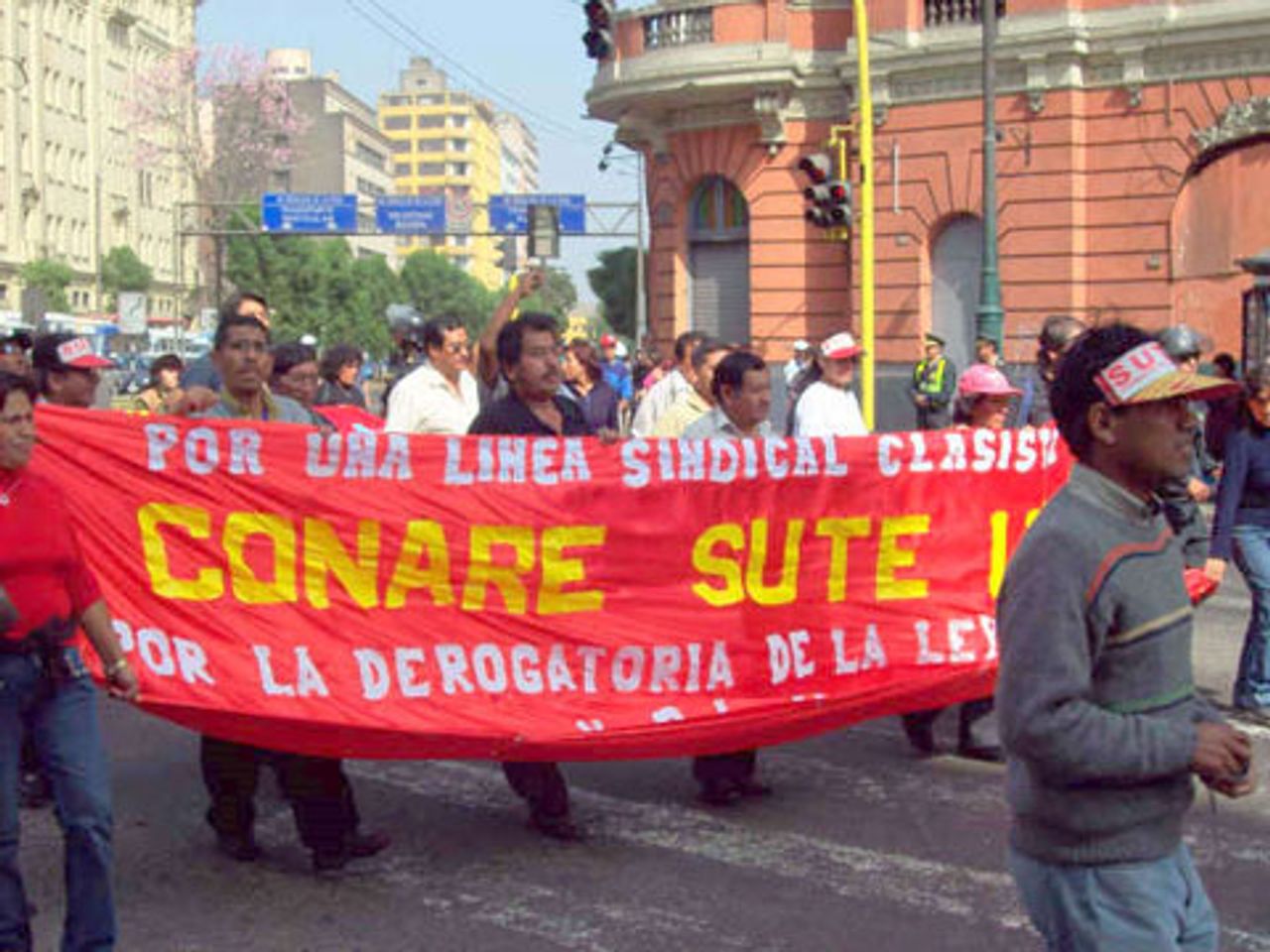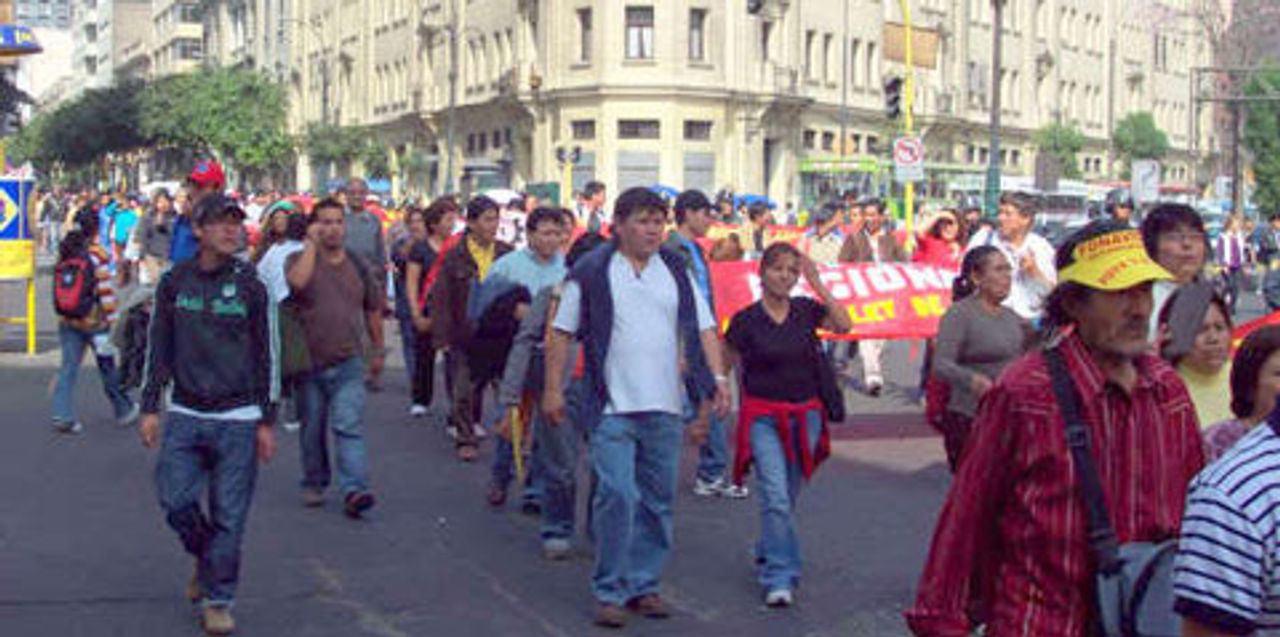 The demonstration in Lima passes by police
The demonstration in Lima passes by policeA wave of mass demonstrations and marches swept across the whole of Peru Thursday in popular repudiation of the government’s massacre of Amazon Indians last week.
Indigenous people from the Amazon region, miners, Andean peasants, urban workers, including major contingents of teachers, construction workers and other sectors, were joined by university and high school students in what constituted the largest action yet against the discredited three-year-old government of APRA party President Alan García.
The protests were met with police violence in various cities, including the capital of Lima.
The day of mass action expressed the outrage of masses of Peruvians over the García government’s ordering of a violent police attack June 5 against Amazon Indians who had been blockading the Fernando Belaúnde Terry highway near the northern city of Bagua. The violence left scores of people dead and hundreds wounded.
The official figures put out by the government claim that 24 police and only nine Indians were killed in the confrontation. Hospitals and religious organizations in the area, however, have reported a far higher civilian death toll, and eyewitnesses told of police burning the bodies of slain protesters and placing them in black bags and dumping them in the river. Many people remain missing. Some of the bodies that were recovered showed signs of being burned and repeatedly shot in the face after they were killed.
 A section of the march
A section of the marchThe demonstrators Thursday also demanded the repeal of two decrees—1090 and 1064—which set the terms for opening up the Peruvian Amazon for the exploitation of energy and mineral resources, as well as logging by transnational corporations. Marchers also called for the resignations of President Alan García, Prime Minister Yehude Simon and other members of his cabinet.
In an attempt to quell the growing popular dismay and anger over the Bagua massacre, the Peruvian Congress decided to suspend the decrees for an indefinite period. The demonstrators rejected this maneuver, demanding the outright repeal of the measures, which critics have charged are unconstitutional, because they violate regulations established by the International Labor Organization and were adopted without consultation with the indigenous people of the region.
Substantiating this claim, Peru’s Constitutional Court has accepted a case brought by the Public Defender’s Office charging that Decree 1064 is unconstitutional.
The APRA government is adamantly opposed to the repeal of the decrees, because they represent an integral part of the Free Trade Agreement signed with Washington. President García fears that the US could declare the treaty null and void, which would represent a debacle for the government’s right-wing economic policy.
In Lima more than 20,000 people began a peaceful march from the Plaza Dos de Mayo towards the congress and the government palace, the president’s residence. Among the march’s organizers were the General Confederation of Workers of Peru (CGTP), Sutep (the teachers union), student organizations and various left parties.
One of the Lima demonstrators sent the following description to the WSWS:
“At 2 pm, I arrived at Avenida Colmena at the corner of Tacna, which was heavily guarded by police. Suddenly, from Avenida Colmena, I heard the teachers of Sutep arriving.
 Contingent of teachers in the Lima march
Contingent of teachers in the Lima march“There were many of them and they were in the street, chanting slogans denouncing the Bagua massacre....
“Then came [to the Plaza Dos de Mayo] the student federations from PUCP and San Marcos...who also denounced García and the massacre. They carried placards with various messages, all in support of the Indians and in repudiation of García.
“Eventually, the crowd began to move down Avenida Colmena—there were thousands of us—past the Plaza San Martín. Once we arrived at Avenida Abancay, suddenly the police attacked us with tear gas. Their aim was to stop us from reaching the government palace (where the demonstration was supposed to end).
“All of the demonstrators ran while the gas reached us. The eyes of everyone running near me turned red and filled with tears—I guess mine did too.
“The people screamed, “We don’t have a president, but a mass murderer!” We headed back up Avenida Colmena until we reached Plaza San Martín where the protest ended. Members of the different organizations spoke against the government and against the repression unleashed on the protest. I saw one person who had been attacked by the police who was bloody and beaten.”
Another student youth who participated in the march in Lima also sent a report to the WSWS saying, “The protest was complicated, because there was a lot of repression by the police, a lot of anger and a lot of chaos, but not much organization. There were a lot of young people from different universities.”
This short note points to an important feature of the June 11 demonstrations. They mark the entry into political struggle by a new generation of students. Also noticeable in the actions in Lima and around the country was the prominent role played by new organizations that have sprung up in opposition to the government, independent of the old parties and union bureaucracies.
There were also demonstrations in various northern cities. In Trujillo, the birthplace of the APRA party, university students and popular organizations marched against the government and in support of the Indians.
 Protesters in the Lima demonstration
Protesters in the Lima demonstrationIn Chiclayo the demonstrators, including students and members of the unions, were blocked by the police from entering the city’s central park. The students burned Alan García in effigy.
The protests in Lima and in the north of the country were particularly significant politically because they were the only regions where APRA won in the last election, delivering the presidency to García.
His opponent, the ultra-nationalist ex-army officer of the Partido Nacionalista Peruano, Ollanta Humala, defeated García overwhelmingly precisely in the areas that are now on the brink of open rebellion against the government—the Andean region and the Amazon jungle.
While most of the major parties of the Peruvian bourgeoisie—APRA, the Fujimoristas and the right-wing Unidad Nacional—united in supporting the suspension of the two decrees, Humala’s party voted against, calling for their repeal.
In the south of the country, there were clashes in the streets of the principal cities. In Puno, a group of 500 students from the University of the Altiplano, armed with sticks and stones, confronted the police. It was reported that in Tacna—a city on the border with Chile—masses of people took to the street, blockading the Pan American Highway.
The peasants in Sicuani began an indefinite general strike and put up barricades across sections of the roads linking Cusco and Puno, Cusco and Arequipa and Cusco and Puerto Maldonado.
In Arequipa, Peru’s second largest city, demonstrators filled the Plaza de Armas where they burned García in effigy and set bonfires.
The central highland cities also turned out against the government’s acts of violence and its economic policy. In Ayacucho the protest was massive, many marching with their faces painted.
In Huancayo, the commercial center of the central highlands, university students blocked the main highway and resisted police attempts to disperse them.
As could be anticipated, the most convulsive region was the Amazon jungle. In April, the indigenous peoples led by the Asociación Interétnica de Desarrollo de la Selva Peruana (Aidesep—Interethnic Association for the Development of the Peruvian Jungle) began a series of protest actions demanding the repeal of the decrees opening up the region for exploitation. Aidesep represents 1,350 communities comprising some 600,000 Amazon Indians.
Rapidly these protests gained wide popular support. In the face of the government’s intransigence, the indigenous people intensified their actions, beginning a series of highway blockades and stoppages of oil pipelines. In support of these actions, there were marches and 24-hour strikes in various towns in the area.
In response, the government issued an order allowing the armed forces to provide support to the national police. It also declared a state of emergency. It is now known that one of the US representatives in the free trade agreement negotiations had expressed Washington’s concern that if Peru failed to meet its commitments to open up the jungle to foreign capital, the US would propose the repeal of the agreement.
Unquestionably, the attitude of the US government played a major role in García’s decision to provoke acts of violence, first expelling Indians who had taken over a pipeline in the south of the country, and then orchestrating the massacre in Bagua.
In the face of the call for the day of action on June 11, the government carried out a mass mobilization of the national police and the armed forces in the population centers of the Amazon jungle.
It ordered the mobilization of police and marines in Pucalpa. The city of Iquitos was militarized, with the government ordering the intervention of the army, the marines, the air force and the police. Pucalpa and Iquitos are the principal commercial cities of the Peruvian jungle. While the air force took control of the airports, the navy took over the main ports on the Ucayali and Amazon rivers.
In defiance of this extraordinary military mobilization, the indigenous peoples of the Amazon turned out in massive numbers. Thousands of shipibo-cunibos, ashaninkas, awajún, sharanahuas and cashibo-cacataibos traveled to Pucalpa to participate in joint protest actions with the CGTP and other organizations.
More than 600 Indian students from the Intercultural University of the Peruvian Amazon in Yarinacochas joined the march in Pucalpa.
Meanwhile, some 3,000 shipibos and ashaninkas in the area of Iparia announced their intention to block the Ucayali River. Similarly, the Indians of the Imiria Lake area, an hour north of Pucalpa, threatened to blockade the Imiria River. Threats of another water blockade came from Tamaya, near the border with Brazil, where 2,000 ashaninkas said they would cut off the Tamaya River.
Schools and businesses shut down throughout the jungle for the day of protest.
In the face of this mass mobilization of the indigenous peoples and the overwhelming support for them from the masses of Peruvian working people, the thuggish acts of repression by the APRA government have only served to throw gasoline on the fire.
Prime Minister Yehude Simon, who in the 1990s was jailed for supposedly being a sympathizer of left-wing groups, has become the principal spokesman for the gangsterism and dictatorial outlook of the APRA party government. Simon has declared that he will not allow a group of people in the Amazon jungle to affect democracy. Now he claims that he is prepared to carry out a dialogue with the indigenous people, but he has banned Aidesep from any negotiations, and the group’s leader, Alberto Pizango, has been forced to take refuge in the Nicaraguan embassy.
In a publicity campaign whose sole motive was to turn public opinion against the Amazon Indians, the government broadcast photographs of police slain in the course of the confrontation in Bagua, denouncing the Indians as “savages.”
The response of the Peruvian population—the Amazon Indians, the peasants, workers and students—has been a clear and massive condemnation of the acts of state violence. The García government is rapidly losing the means to continue governing the country through the forms of bourgeois democracy and is moving towards dictatorial methods to defend the Free Trade Agreement and the interests of both foreign capital and its junior partner in Peru’s ruling oligarchy.
